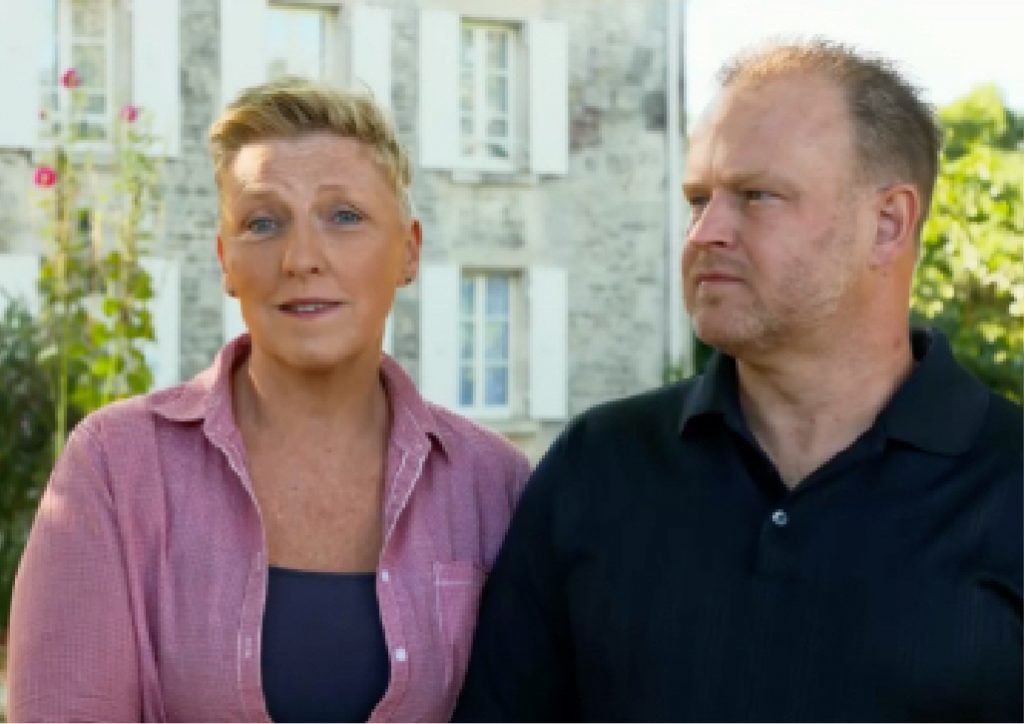Château de Saugé
Paul and Donna
Paul and Donna have lots of experience in property and renovations. But buying and restoring the Château de Saugé in the Deux Sevres region of western France is by far the biggest project that they’ve ever undertaken.

Buying a Château de Saugé is not for novices
When you look at the sites of the châteaux that feature on owners’ websites, they look such impressive venues that it’s hard to ever imagine them in a dishevelled run down state.
Yet that’s the condition that a lot of the owners will buy them in.
It takes an expert eye to value a big building’s worth
Of course when you watch the shows you see the expertise that’s put into rebuilding and refurbishment. But it takes an awful lot of time and money to restore a château to a state where it can begin to earn an income.
It also needs an expert eye to make sure that a property is worth purchasing.
Donna and Paul Newman could hardly have better credentials
Scotsman Paul is a quantity surveyor by trade and Donna, from Hartlepool, a property and facility consultant. They met and married in the UK in 2003, then bought a 400-year-old cottage to refurbish in central Scotland. And over six years they extended it from two bedrooms and one bathroom to six bedrooms, three reception rooms and four bathrooms.
Moving to the Middle East
Next they moved to Dubai in 2008, where for 10 years Paul was chief commercial officer working on many projects with major development companies and Donna was a property manager.
So there aren’t many people better equipped to evaluate a château.
Planning a trip to France?
The French connection
Despite living in the Middle East, Paul and Donna always felt an attraction to France.
They knew the country well after numerous car tours around Europe over the years, and loved the people, countryside, food and drink. They also loved the price of property, and knew they could get far more for their money here than anywhere else in the world.
More for your money
You’ll probably have noticed that the cost of a château in France is much better than if you bought the same place in the UK. But before you leap in with an offer there are other factors to take into account. You’ll need to put in a lot of money into most of these buildings to make them viable as a business. And, if you want to start earning an income, you’ll need to do it quickly.
Step inside and step back in time
When Donna and Paul saw Château de Saugé in March 2018 they immediately fell under its spell. They felt it was like walking back in time when they went inside, with its domed ceilings and its own vaulted caves.
It was, however, a shadow of its former self.
The repairs would cost more than the château
This is where the Newman’s expertise and experience was so important. They knew that it would cost two or three times the amount that they would have to pay for the house in order to restore it and bring it back to life. And they had that figure in mind when they made their bid.
The offer was rejected and the couple returned to the Middle East.
Better luck next time round
However when they returned to France to start searching for a property again, they noticed that the Château de Saugé was still up for sale. They made another offer and this time their bid was accepted.
From Thailand to France
To complicate matters, during their time in Dubai, the pair had also bought property in Thailand. And at the time of their successful bid they were living in Phuket, an island off the Thai coast. From making a bid to moving in was rapid.
Ownership at last
Handover of Château de Saugé took place just eight days after they landed in France.
And they moved into the building in October 2018.
However all the Newman’s furniture and belongings were being shipped over from Thailand and didn’t arrive until December.
The initial moving in was the hardest
It was winter and the château was in such a state it couldn’t keep any heat in, and was leaking. There was also acclimatisation from Thailand to France to take into account. It wasn’t easy to adjust from the 40-plus degrees heat of Thailand to the minus temperatures of a Poitou-Charentes winter.
How to put your feet in it
They knew the building was in a state.
When the insurance man came out to inspect the house prior to giving a quote, he’d put his foot straight through the attic floor. And they found themselves knee deep in old plaster, rotten timbers and the occasional rodent.
But slowly and surely they have made progress
The house itself was clean and liveable on handover. And they had bought furniture from the owner, so they had things like beds, and could live in relative comfort while they did the restoration.
Make a list of priorities
Initially they simply identified a list of everything that needed doing, from rewiring to plumbing to sorting out the roof, and then prioritising jobs.
Once again the Newman’s experience proved invaluable, as they could work out what spend was needed to make an area usable, versus the income that area could make.
Tea comes first, of course
And using that criteria, the first step to allowing the public back in was opening the vintage tea room.
Now they’re making progress, they are creating suites that are very different to each other, with an appropriate name to match.
Different suites with different themes
So, for example, there’s a Victoria suite that got its name because Donna had a 100 year old Union Jack that she wanted to feature as a focal point, a Highlander room because Paul is Scottish, a Royal Suite because of the wedding events the couple hosts, and so on.
Many challenges to overcome
As you’d expect with such a massive property, there have been many and varied challenges.
These include having a bathroom for the tearoom, dealing with French bureaucracy, and adhering to modern rules and regulations like including disabled access into a very old building which involved cutting through 900mm stone walls to create the necessary space.
The couple’s solutions can be very creative
For example, Donna is a baking fan and she came up with the idea of using piping bags to point sandstone walls, which meant less mess and waste and a better finish.
Despite its age, much of the château’s history is a mystery
Paul and Donna know that in 1607 the Château de Saugé was built by the Rion family.
But the caves are much older and were part of whatever came before.
They’re doing their best to fill in the gaps, and have joined a local history group to see what they can research. They’ve also taken the unusual step of getting in touch with the previous owners.
The château was separated into four apartments during the 1950s, and some of the families whose grandparents were tenants have been in contact and shared family pictures, which you can see on their website.
Business is good
Despite a slowdown caused by the pandemic, business is growing, with a mixture of British, Dutch and local people staying.
The Château show has also bought in a lot of people, and now they’re also getting messages of support online from all around the world.
Still rebuilding
Despite all their experience the Château de Saugé is by far the biggest project that Paul and Donna have ever undertaken. And it’s still going on.
Which means that every time you visit, the building will be even better than before!

Booking Enquiries
Find out more or to book a stay – contact the owners here

